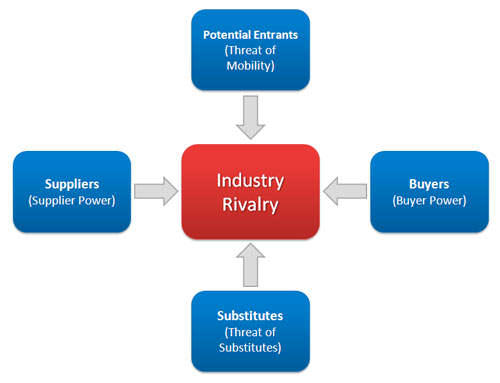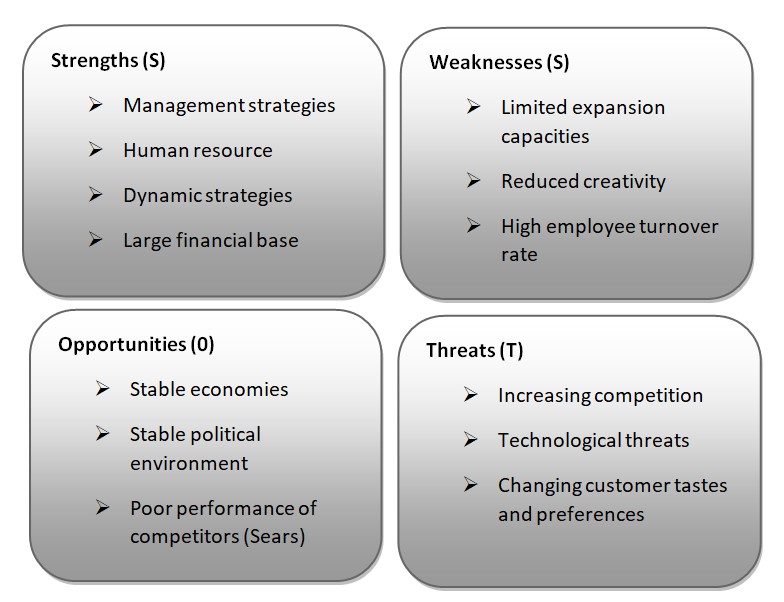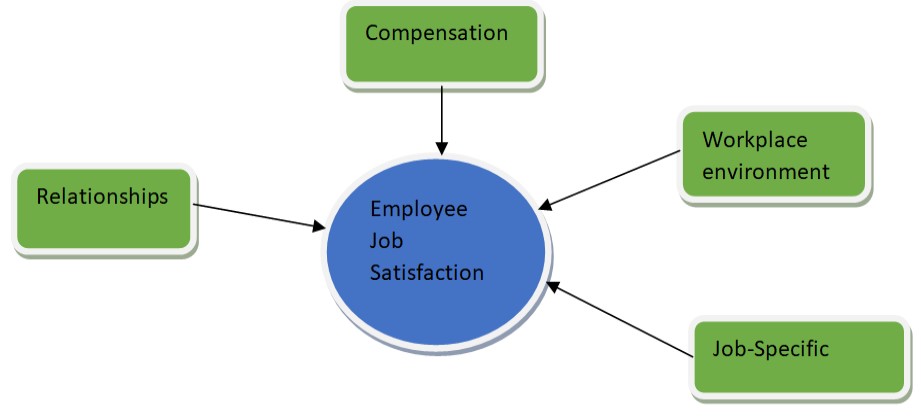Executive Summary
Target Corporation is one of the leading retailers in the United States. It is ranked third-largest retail store after Walmart and Kroger. This firm has experienced a long period of prosperity, especially when it expanded its operations to Canada. One of the main strengths that have enabled this firm achieve its current success is its flexible management approach.
The firm has been very sensitive to changes taking place in the external environment. However, its inability to retain its employees has affected it negatively. To address this issue, the management should develop a new system focused on employees’ satisfaction. This model should address issues such as the working environment, compensation, assigning of tasks, and the relationship between employees and the management. The focus should be on improving employees’ experience. If done properly, this firm will improve its competitive advantage over its market rivals.
Introduction
Target Corporation is one of the largest retailing companies in North America. The firm has been keen to ensure that its operations are in line with the company’s mission statement. As Aaker (68) notes, the mission statement of this firm states, “Our mission is to make Target the preferred shopping destination for our guests by delivering outstanding value, continuous innovation and an exceptional guest experience by consistently fulfilling our brand promise.”
George Dayton started Target Corporation in 1902, and currently the firm’s headquarter is in Minneapolis, Minnesota, in the United States. Market competition was not very stiff when this firm started its operations, but there were well-established firms operating in the same industry.
Over the years, Target has grown to become one of the giant retailers in the world. Target is currently the third largest retailer in the world, with most of its stores located in the United States and Canada. The management of this firm has been consistent when it comes to implementation of the emerging technologies. Target Corporation is one of the retailers that have been keen on using the emerging technologies to improve their service delivery methods. The following pie chart shows some of the competitors of this firm and their market coverage percentage.
In the current competitive market, firms have come to realize the importance of strategic alliances. In its international corporative strategy, this firm has emphasized on developing strategic partnership with its suppliers such as Samsung, Sony, and many others. This alliance creates a partnership where destiny of this firm is tied with the destiny of its suppliers. This way, the suppliers will make any effort to create a positive working environment so that this firm can succeed for the benefit of all.
According to Stevenson (113), understanding a firm’s business-level makes it possible to determine its potential in the market. Roberts (78) says, “Business-level strategy is concerned with a firm’s position in an industry, relative to competitors and to the five forces of competition.” As mentioned previously, Target is the third largest retailer in the world. This means that its competitive capacity is relatively high as compared to most of its rivals in the market. In its strategy, the firm has focused on aligning its strategies with that of the prevailing market forces. All its subsidiary branches are always operated based on the strategy developed at the headquarters.
The strategic alliance strategy with the suppliers is very appropriate for this firm. Target Corporation is facing stiff competition from Walmart and many other large retailers in this region. Unlike Walmart that currently has a global market coverage, this firm only operates regionally. This strategic alliance with suppliers who have dominated the world market will help it discover other markets around the world.
External Analysis
The external business environment plays an important role in determining success of a firm in the market. The chart below shows six core business environmental elements that have direct impact on the operations of this firm.

As shown in the above chart, these external environmental factors affect Target’s operations to different levels. The United States and Canada have very stable political environment, and therefore, it has the least impact as shown in the table. Economic and technological elements have the highest impact. The following chart shows the industry’s five forces based on Porter’s theory.

As demonstrated in the above diagram, this firm must know how to deal with threats of potential entrants, the power of suppliers, the power of buyers, the threat of substitutes, and finally the industry rivalry. As indicated in the diagram, industry rivalry poses the most serious threat to this firm. For instance, Walmart and Kroger have the largest market share. Their market growth has also been stable in the last decade, a sign that they are determined to maintain their market lead. Unless Target Corporation comes up with a brilliant strategy, it may be difficult to dislodge the two firms from their lead. They will continue posing threats to Target Corporation.
It would be important to understand competitors’ strengths and weaknesses in order to determine the best approach of managing their threat. The table below shows competitors threats and weaknesses.
It is clear that managing competition in the market is the most important factor that this firm should consider. The charts shown above indicate that Walmart has been very prosperous in the market, and has increased its market share over the years. If the management of Target Corporation does not find a way of dealing with this threat, it may be forced out of the market.
Internal Analysis
Internal analysis is always important in enhancing understanding of a firm’s current capacity. Target should consider enhancing its value chain management strategies in order to gain competitive edge over its customers. As Roberts (91) notes, firm’s must ensure that they offer maximum value to the customers in order maintain high levels of satisfaction. Value chain management focuses on all the activities carried out within a firm at all categories. The figure below captures the stages and resources involved in value chain management.

Inbound logistics, operations, outbound logistics, marketing, and customer service are some of the core activities in value chain management.
Understanding the financial ratios of this firm will also help in understanding its financial capacity to address various issues in the market. Liquidity ratios are important in understanding a firm’s capacity to meet its short-term financial obligations. Current ratio, quick ratio, and cash ratio can be used. Other important ratios that can be used to Analyze Target Corporation’s financial capacity include profitability indicators ratios, debt ratios, performance ratios, and investment ratios. The tables below show income statement and cash flow of Target Corporation for the years 2011, 2012, and 2013.
The data from the two tables can be used to compute some of the important ratios of this firm to help in understanding its internal capacity. Target’s non-financial internal factors have also played a big role in ensuring that it is successful. The management has been conscious of the changing environmental factors. This has made this firm flexible to changes in the environment. Its organizational culture and frequent engagement in corporate social responsibilities has also given in a competitive advantage in the market.
In order to analyze the competitive advantage of this firm, VRIN analysis would be important. The firm has been focused on generating value out of its current operations. Its approach in managing its online stores has not only been considered as rare, but also not easy to imitate by competitors. This is so because of the improved software it has uses in its information management (Stevenson 93). As demonstrated above, value chain management is the best way through which this firm can manage market competition.
SWOT Chart

The diagram above shows a SWOT analysis chart for Target Corporation. From the chart above and discussion from other sections of this paper, the major strength of this firm is the management strategy that has been employed in the recent past. The strategy has emphasized on the firm’s need for flexibility in its operations. This has enhanced dynamism in its operations. The firm has been sensitive to the changing environmental factors. This has enable it benefit from the stable economic growth experienced in the United States. It has also helped it deal with the threat posed by its market rivals. However, high employee turnover has been considered as a weakness that has reduced its capacity to increase the market share in areas where its main rivals like Sears are failing. This increases the cost of training the employees.
Critical Strategic Issue
Target Corporation is a successful retailer that has managed to expand its operations in the market over the years. However, one critical strategic issue that it has to deal with is the rate of employee’s turnover. According to Aaker (80), Target Corporation has not been rated as one of the best employers in the recent surveys. In the recent past, the national dailies made reports that some of the employees were complaining of the rigid schedules. Others have complained of forced-overtimes.
The firm has witnessed cases where its employees reassign after being trained on the best practice in their areas of operation. When they leave the firm, they are hired at rival firm’s transferring all the knowledge they had learnt and the experience to these competitors. This has affected the firm’s capacity to excel in the market, giving its competitors an edge over it.
Strategy Recommendation
According to the above analysis, it is clear that the biggest weakness that Target Corporation has is its ability to retain its well-trained employees. Employees are the most important asset in any organization (Stevenson 23). The SWOT analysis conducted above shows that this firm has not performed well in the market because of this issue.
To address it, the firm should develop an appropriate employee satisfaction strategy that would help in maintaining employees within the firm. The management should focus on employee satisfaction. The proposed model that this firm should use focuses on all the issues that relate to employees’ well-being in the firm. The following chart shows some of the components of this employee satisfaction model.

This strategy is tailored not to interfere with the activities of Target Corporation’s competitors. This internal change management would be focused on improving the working experience of the firm’s employees. To ensure that there is efficiency in implementing this new strategy, the management will use McKinsey 7S model to ensure that all aspects of the organization work harmoniously when this new model is implemented. The chart below shows McKinsey 7S model.
McKinsey 7S Model

As demonstrated in the model above, the focus will be to ensure that the strategy is based on the shared values. This means that the new strategy should not jeopardize other areas of the firm negatively. It should bring a positive change in the entire management system. The focus will shift from productivity-focused management approach that has been practiced in this firm, to a comprehensive approach that looks at all areas of operation, including concern for employees. When implemented effectively, the firm will be able to retain its employees, and this will improve its efficiency in the market.
Works Cited
Aaker, David. Developing Business Strategies. New York: Wiley, 2001. Print.
Roberts, Bryan. Walmart: Key Insights and Practical Lessons from the World’s Largest Retailer. London: Kogan Page, 2012. Print.
Stevenson, Lawrence. Power Retail: Winning Strategies from Chapters and Other Leading Retailers in Canada. Toronto: McGraw-Hill Ryerson, 1999. Print.